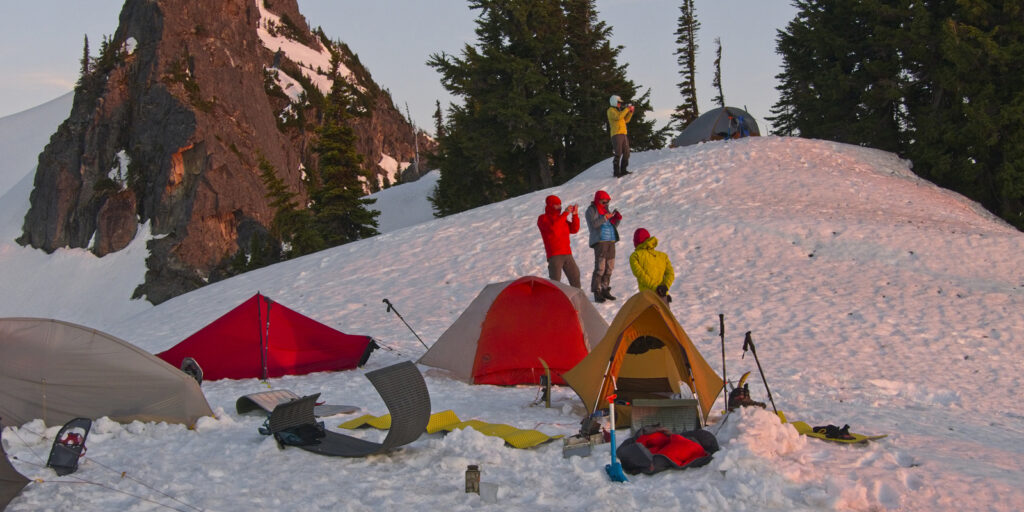Be Part of the Winter Backpacking Team
Winter backpacking is a great way to make life-long friends and memories. Although our main focus is winter trips, we do hiking events all year long, including day hikes near Seattle for conditioning, trips in the ridges and peaks of the Cascade Mountains, and longer section hikes of the Pacific Crest Trail. We begin each year with short trips for beginners and progressively take on longer and more difficult routes as the year unfolds. If you are passionate about the outdoors, backpacking and hiking, come join us and explore the beauty of Washington State.
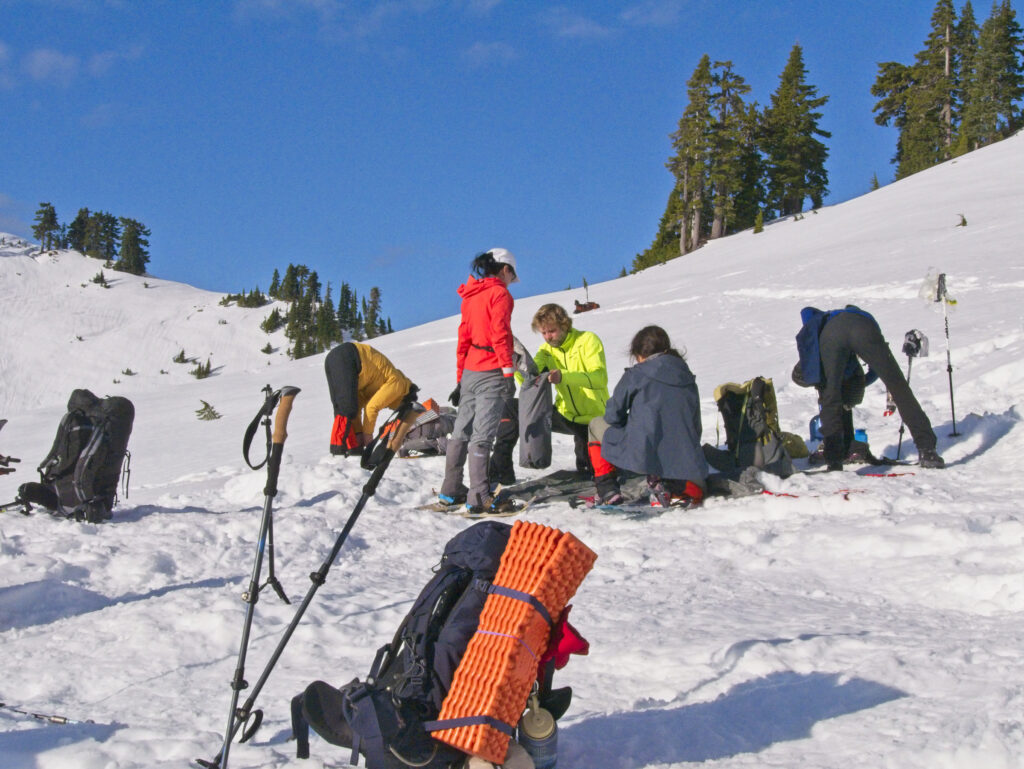
Important Group and Safety Information
This page includes essential safety and liability information. If you join the Winter Backpacking Meetup activities it is assumed that you have read and agree to the release of liability. See Liability Agreement in the red box on this page.
Our Winter Backpacking Meetup page can be found here: https://www.meetup.com/Winter-Backpacking-in-the-PNW/
You are responsible for yourself. Organizers are only organizers. They are not leaders and they are not responsible for your safety. Before each winter trip, it is your responsibility to check:
• weather (https://www.mountain-forecast.com/)
• avalanche forecast (https://www.nwac.us/)
• gear and route requirements
You must arrive self-sufficient. This is a free Meetup group, not a mountain tour service. This Meetup exists to bring hikers together who are interested in winter backpacking. Traveling in a group increases safety, but everyone is responsible for their own safety, comfort, and well-being. Everyone is required to be fit enough to complete the trip, able to carry the necessary gear and know how to use it and be able to solo camp if necessary. Everyone is learning. It is your responsibility to understand the level of risks you are accepting and do your own route research and decision-making.
Beginners are welcome
Most of the trips posted will be one- or two-night trips.
A few will be longer.
Beginners are welcome, but you must be fit, have the appropriate gear, and have some experience backpacking. Prior experience snow camping and snowshoeing are recommended. To participate you must join the Meetup and agree to the release of liability.
Have questions? You can contact organizers via the Meetup page or post questions on the event pages to find out more about gear, methods, and expectations. Group members are friendly and willing to help. We are an inclusive group and welcome diversity.
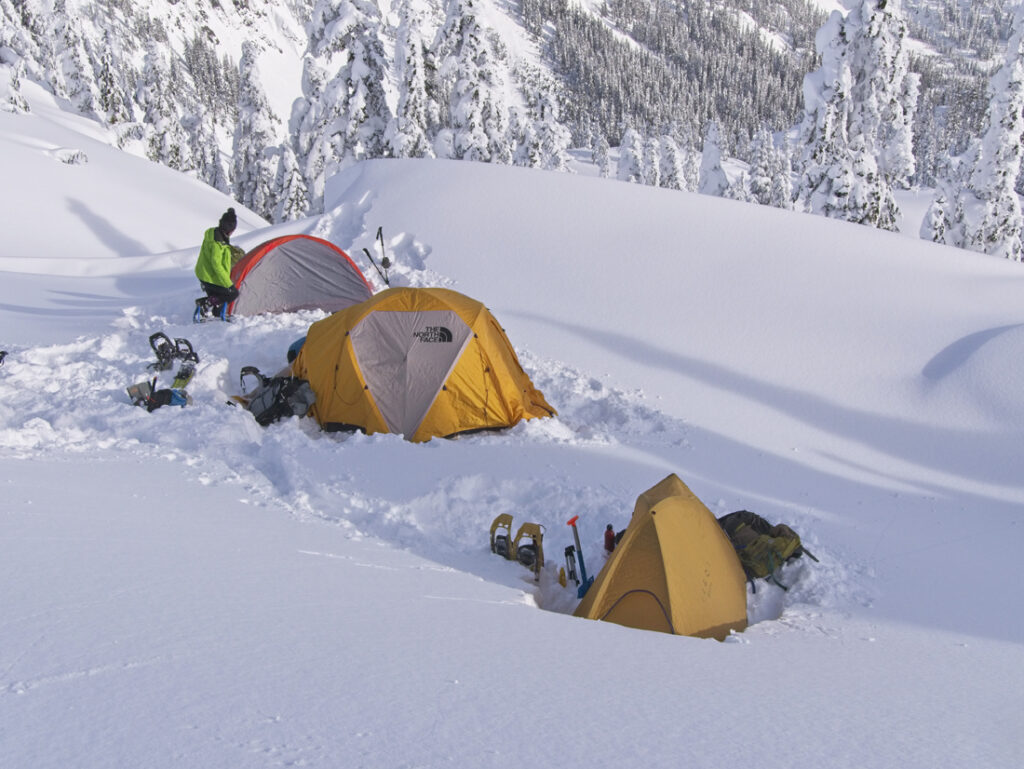
Trip Planning
Cloudy weather will cancel some weekend plans. Some trips will be rescheduled for weekdays. Good-weather weekends are not always possible. Weekday trips, therefore, will sometimes be arranged on short notice. For most trips, there needs to be at least one day that is partially clear. Hiking in snowy weather, even near white-out conditions, is acceptable, but hopefully, there is some clearing in the forecast.
Transceivers, Probe, and Shovel Practice: When there is low cloud cover in December and January some trips will be converted to single-day avalanche rescue practice (transceiver use and search) at Snoqualmie Pass at the far end of the Alpental Access Road (Source Lake Trailhead-Alpental Lot 4/Upper lot).
Group Size
Group size is typically 3-6, but some events will have 6–12. The Wilderness Area size limit is 12. No group will ever exceed 12.
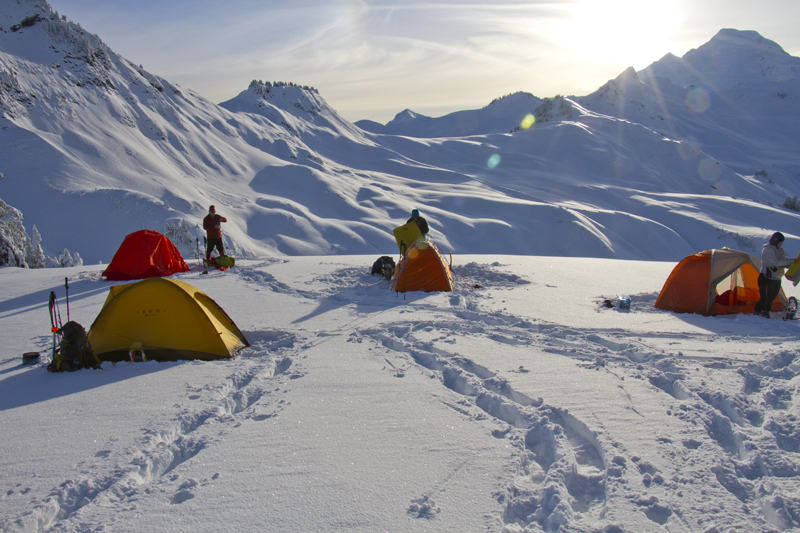
Expectations
Where are some good places to backpack during the winter months? Most winter hiking lists stress low-elevation trails with no snow, such as trails along rivers. The purpose of the Winter Backpacking group is to seek out snow for as much of the year as possible. Snow camping is the lowest impact method of camping and, of course, the snow is beautiful and comfortable. Always expect and be prepared to camp on snow or ice.
Skiing, snowboarding, and short snowshoe trips are considered normal, but for many people, hiking has a “season” that doesn’t include winter. Most trails are considered impassable in winter, but with the right skills, equipment, and route finding, it is possible to enjoy hiking and backpacking in the winter, especially in the mild winters of the Pacific Northwest.
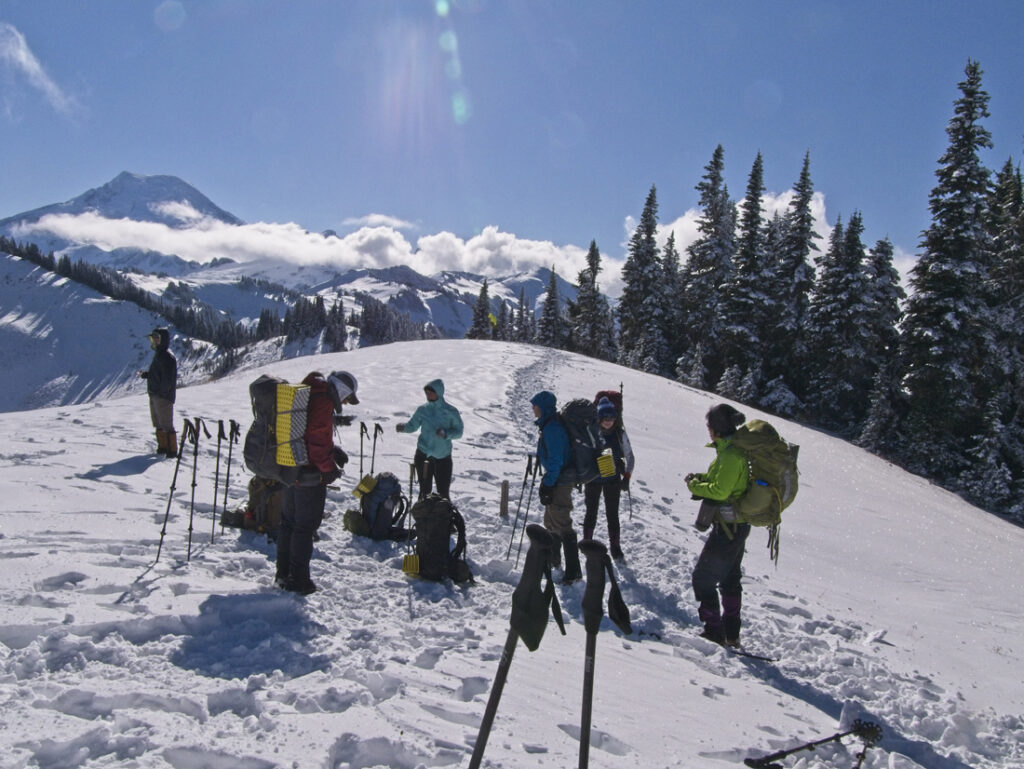
What makes us different
Winter backpacking means snow travel (usually snowshoes) with an overnight pack. Most available snow camping information is for people who are car camping or going very short distances with heavy gear. This group and website provide specialized information for snow travel and snow camping with light packs.
Winter backpacking skills can save your life. Many rescue stories involve hikers caught in unexpected cold weather at high elevations, early-season snowstorms, and whiteouts. With preparation and simple winter skills, many of these rescues would have been unnecessary.
Winter backpacking skills allow you to enjoy and remain comfortable and confident in conditions that others consider harsh.
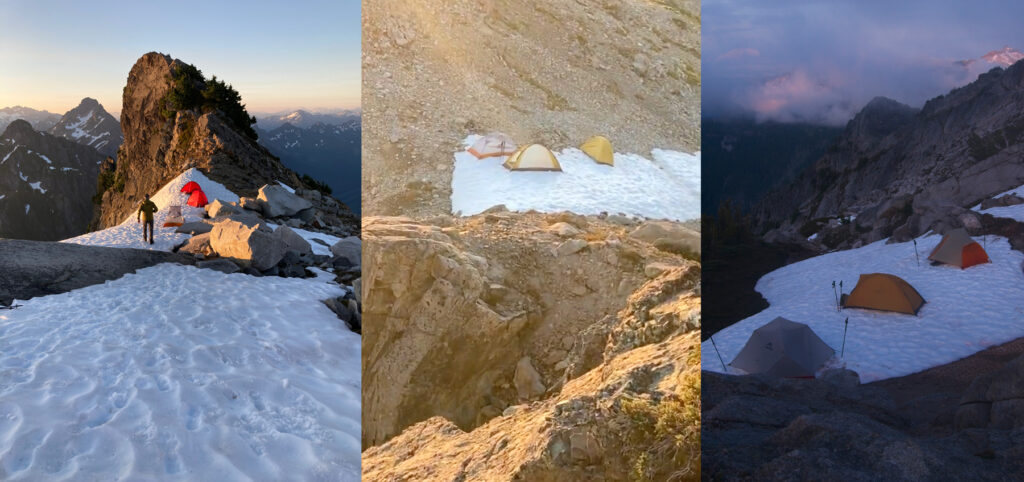
Backpacking in the winter allows for a unique high-reward and unforgettable experience. It is the most low-impact leave-no-trace way to experience the wilderness. Whether it is a stunning moonrise or glowing sunset or emerging from a whiteout to a crystal clear sky or camping on a frozen alpine lake, winter backpacking is unlike any other kind of experience.
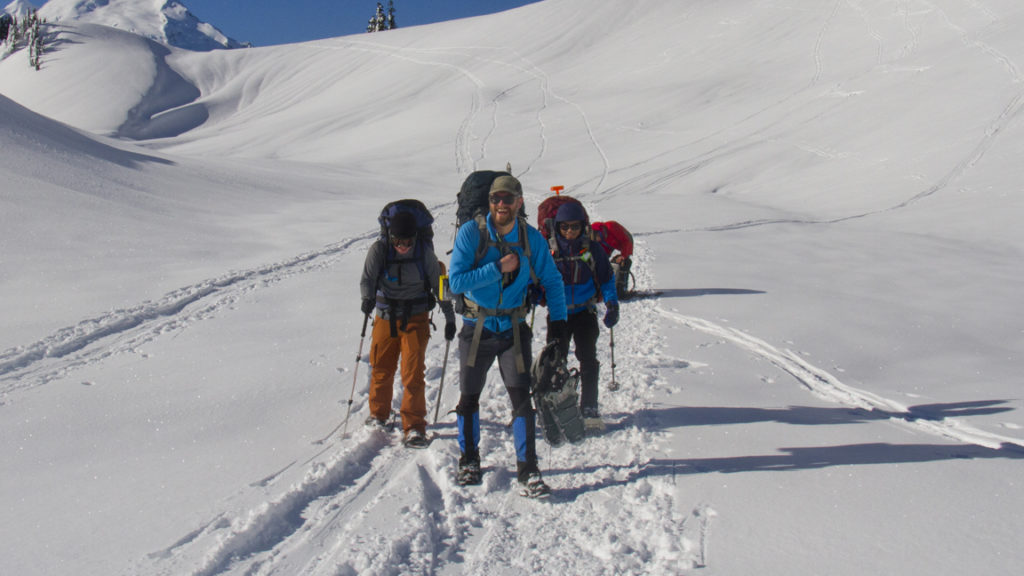
Caring for the wilderness
In the PNW most people hike July-September and this puts considerable strain on the trails. Oregon is now expanding permit areas and the same is likely to happen in Washington State in the years to come. The Enchantments had over 17,000 visitors in 2017 with 3000 overnight permits issued (over 20,000 people applied). These permits are just for May 15 through October 31.
One solution is to turn this around and hike September to July, rather than July to September. The advantage is more freedom, solitude, and less environmental stress. This approach requires lighter gear, route-finding skills, snow travel skills, and avalanche awareness, but the rewards are higher. Winter backpacking allows hikers a true backcountry experience.
Most trips will be in Wilderness Areas, National Parks, or Alpine zones. These are very special places and it is up to us to protect them.
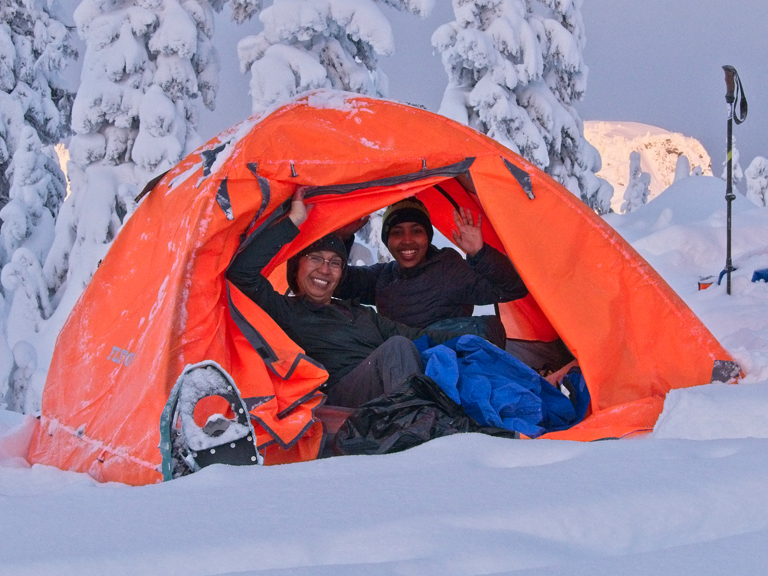
Fires, trail dogs, human waste, large groups, etc.
Everyone is expected to follow leave-no-trace (LNT) practices. The standard LNT practices were developed and promoted in the 1970s and 80s after National Park visits dramatically increased from around 3 million (1958) to 20 million (1967). Today the number of annual visitors exceeds 300 million, but leave-no-trace recommendations have changed very little.
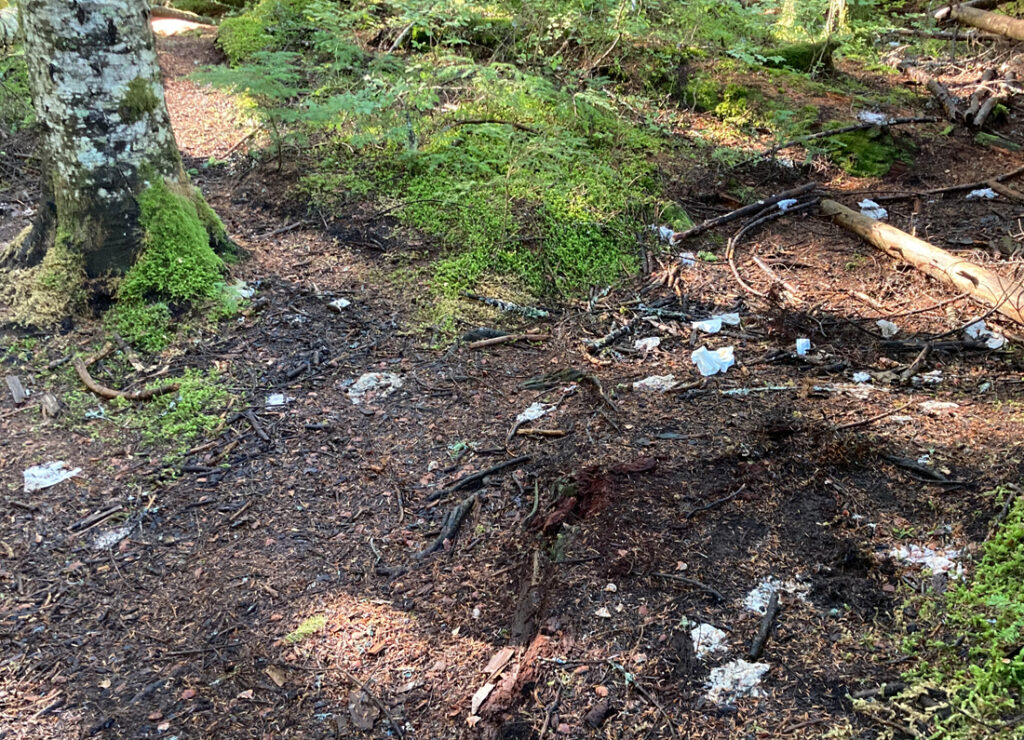
Those managing National Parks and Public Lands are unable to protect the land and for this reason, they rely on encouraging people to be better stewards of the outdoors. Leave-No-Trace (LNT) Education and awareness are thought to be the best methods, partly because regulations can’t be enforced and people often retaliate against rules, making the rules counterproductive. With the standard LNT guidelines failing, it is worth considering how we can do better?
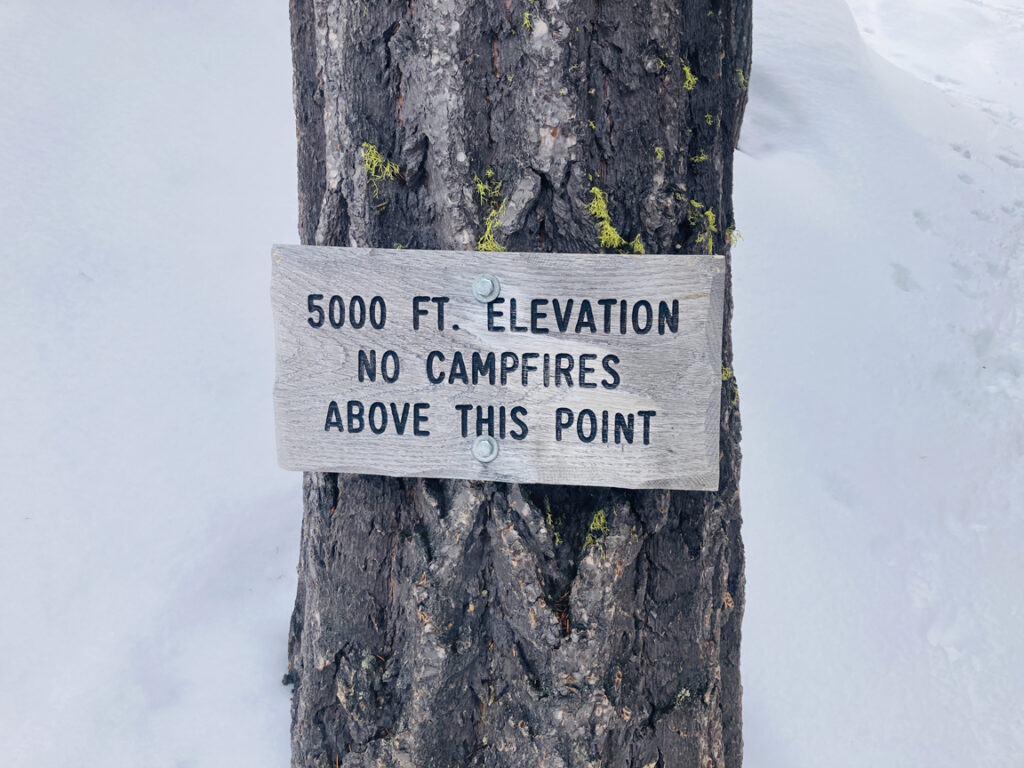
Here are some LNT 2.0 suggestions:
- Travel more off-season and less during the high season
- Always camp on snow when possible (easy to do in the PNW, September–June)
- No campfires (campfires are unnecessary even in winter and usually prohibited in Alpine areas due to the lack of organic materials and the impact fires have on the landscape)
- Only use liquid fuel or canister stoves (no alcohol or wood “twig” ultralight stoves)
- Travel in smaller groups (3–12)
- Use WAG bags (pack out human waste)
- Leave pets at home. Pets are great companions, but unfortunately, they are sometimes unhappy in cold weather and deep snow, impact ground-nesting birds and other wildlife, and unintentionally puncture air mattresses (which happened on one trip causing several people to turn back after the first day).
- Do not run or travel fast on trails as this activates the prey instinct of predators, resulting in human/predator conflicts, with predators being put down.
- Use social media cautiously: Avoid including specific locations or names of destinations in your personal social media posts.
Have thoughts and suggestions for better LNT practices? Your comments are welcome and you can share them here: Rethinking Leave No Trace.
We are not just sharing a fragile land with millions of other human visitors, but with many species that have no other home. We may be the last generation to experience this privilege. Let’s do what we can to create a better LNT hiking culture.
Respect other hikers in the group.
Be considerate of others and respect the quality of their experience. If, for example, you want to bring music, bring earbuds or headphones. We want to have fun, but for the safety and consideration of the group, let’s keep it smoke-free, and drug-free (non-prescription drugs), and limit or avoid alcohol (drinking alcohol in the cold lowers your core temperature).
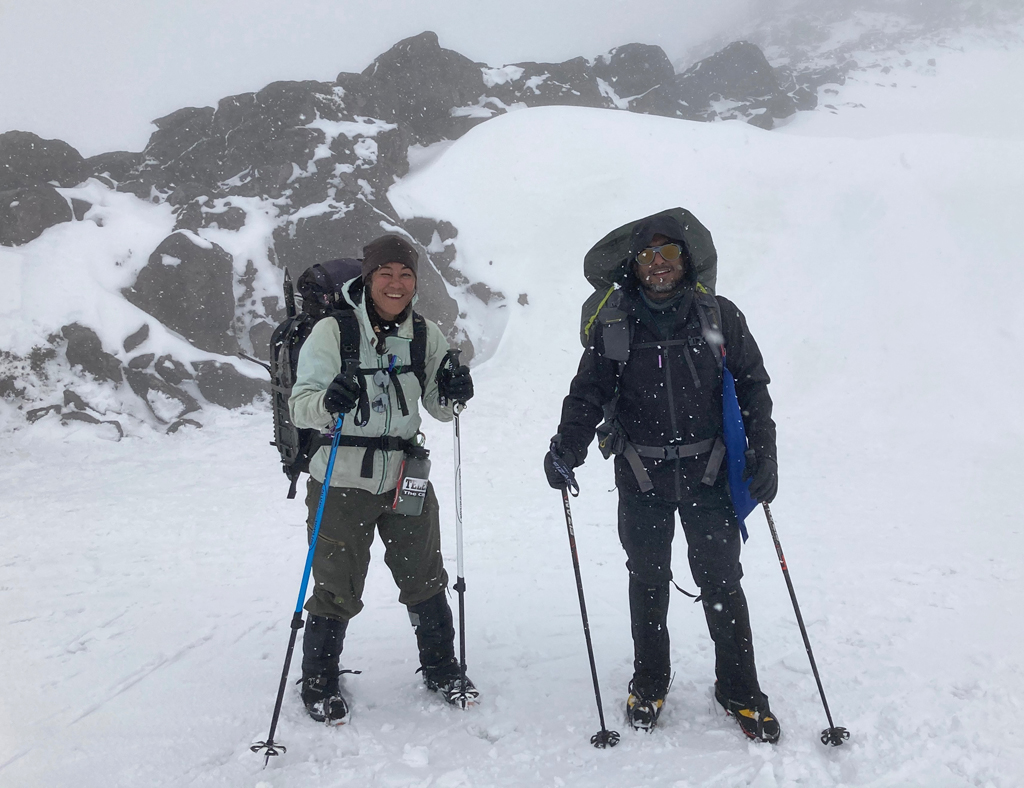
Carpooling, restaurants, and cafes: We will try to carpool whenever possible, so bring a contribution for the driver if you are a passenger. As a courtesy, a change of shoes and shirt is recommended for the drive back to help keep the cars clean. For most trips, we will stop for coffee on the way to the trailhead and stop for food and drinks after the hike. It helps if everyone avoids having other plans that inconvenience the group.
Safety
Backpacking in the Cascade Mountains is dangerous and people get injured and killed doing it. None of the planned events are risk-free. If you are seeking safe, risk-free recreation, you should probably consider some other activity. There are many risks including slipping and falling from high elevations, hypothermia, and avalanches. If you are concerned about predators, such as bears, mountain lions, or humans, bring bear spray. Please do not bring lethal forms of self-defense.
Avalanche Gear
Everyone is encouraged to bring at least a transceiver (also called a “Beckon”). If you can, please bring a transceiver, probe, and shovel. We have seen avalanches on the trails even when NWAC had posted “Low” on the Avalanche Danger Scale. On some trips, a transceiver is required, so if you are serious about winter recreation, acquire a transceiver.
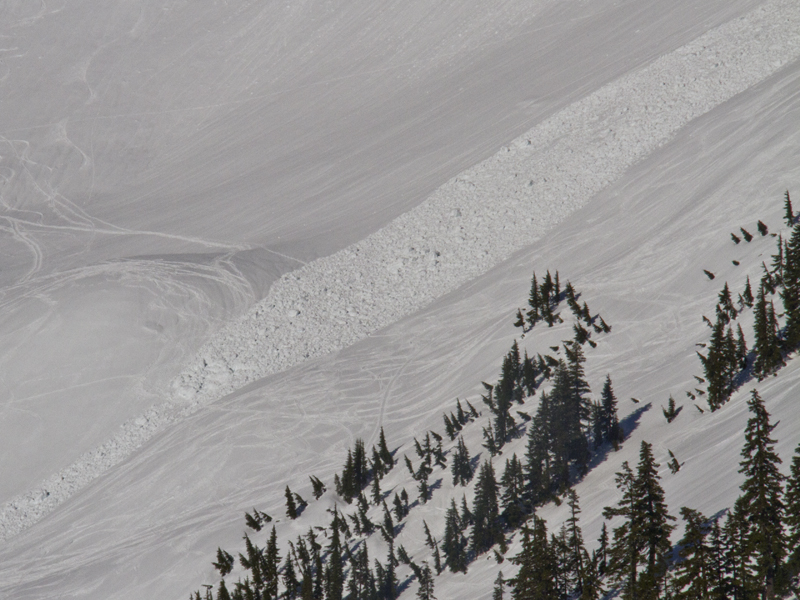
As examples, these are the avalanche gear choices I use:
- Check out this Gear Lab article for beacons: Best Avalanche Beacon of 2023. I’ve been using the Black Diamond Pieps Powder BT for years (11.6 oz with batteries and case and usually around $340). All avalanche transceivers use the same 457 kHz frequency and will work together.
- Backcountry Access B-1 EXT Bomber Avalanche Shovel. 1lb 5oz. (About $50)
- Black Diamond QuickDraw Tour Probe – 240cm. 10.4 oz (About $60) Probes are usually 240cm to 320cm. Longer is better.
This gear combination will cost $450 and add 2 lbs to your pack and another 11.6oz around your torso. It may seem like a lot of money and weight, but it is insurance that could save your life or help you save someone else. Even apart from avalanche rescue, the snow shovel is a frequently used tool while winter backpacking.
Turn your transceiver on at the trailhead and leave it on
Avalanche hazards are real. Learning to avoid them is important. You can be buried and suffocated, die from hypothermia, or be crushed. In most instances, you cannot outrun an avalanche. Once buried, you will be unable to move, so your transceiver must be turned on to the “send” mode so that others can find you.
Your batteries will last over 200 hours in transmit mode, so turn on and test the beckon at the trailhead and leave it on. Don’t risk turning it off and forgeting to turn it back on.
Avalanche gear will not guarantee your safety. Rather it will increase the chances that you will be located if buried and it will increase your ability to help rescue others.
Recommended reading: Avalanche Essentials: A Step-by-Step System for Safety and Survival by Bruce Tremper, Mountaineers Books (Paperback).
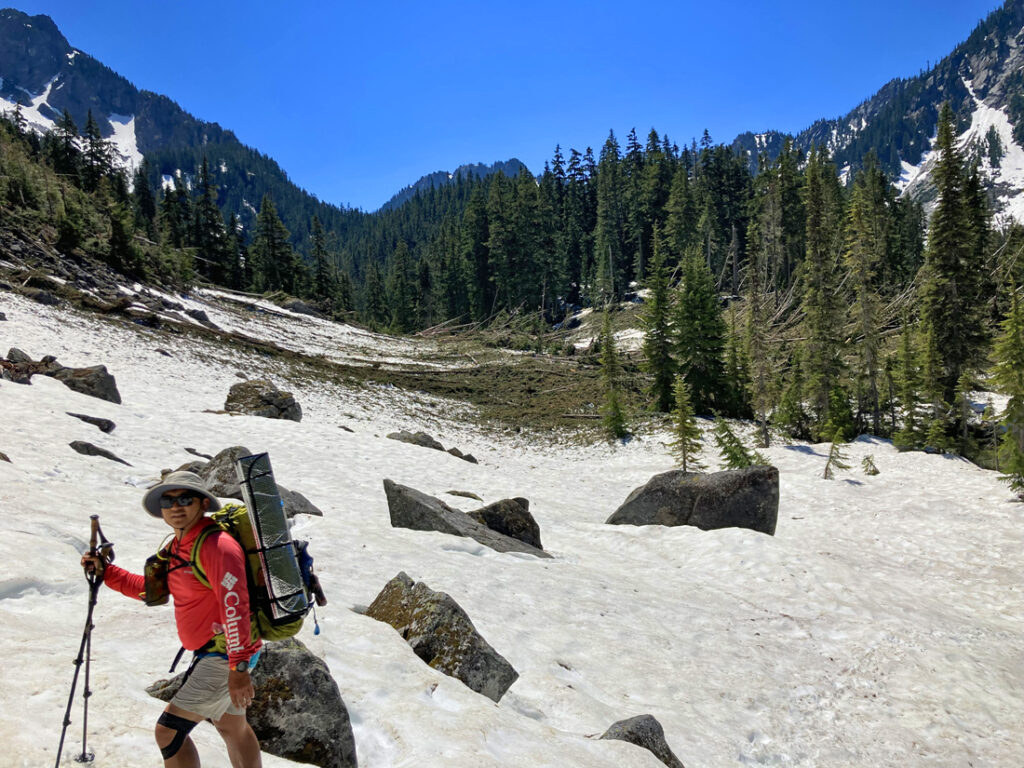
Liability
- Everyone must read and agree to the release of liability. Provide (email) a clear statement such as “I have read and accepted the terms of the release of liability.”
- Let your loved one know you are involved in these activities and that you have agreed to the release of liability. Put the name of a contact person in the lid or outer pocket of your backpack. Always let someone know your itinerary.
- We travel in a group to increase safety and help one another, but we are often spread out, there are no “guides” or “leaders,” and no one has signed up to take responsibility for your safety or comfort.
- No experts are provided. There are no avalanche experts, no first responders, and no medical professionals provided.
- No phone service is common. There is usually no phone service in the wilderness.
- Mountain rescue, if called may not be able to respond for 6 hours to a day, depending on circumstances and weather conditions, such as high winds. A recognizable Meetup profile photo is recommended because it could help if a search is ever required.
- Everyone is a learner trying to increase their skills and safety.
- Be prepared for the same risks and take the same precautions you would take if you were backpacking alone in winter conditions.
- Arrive self-sufficient. Our goal and practice is to stay together at all times, but everyone must be prepared for the possibility of getting separated from the group. Everyone is required to be sufficiently fit to complete the trip, aware of the route, and capable of solo camping if necessary. Do not plan to distribute any of your gear to someone else in the group. If your gear is too heavy, use the information on this website to learn how to lower your pack weight. A typical complete winter pack for a weekend trip should be in the 26–35 lbs range.
- Use a checklist and do a visual gear inspection before packing.
- Check the route and be able to navigate. Organizers are only trip organizers. That is, they select meetup locations, destinations, and connect the members. That’s all. No one is paid. They may or may not have no prior knowledge of the trail conditions or prior experience on the planned route. You can learn more about trip planning here: Trip Planning.
- YOU are responsible for evaluating the weather, avalanche, and terrain conditions and managing the known and unknown risks you are accepting.
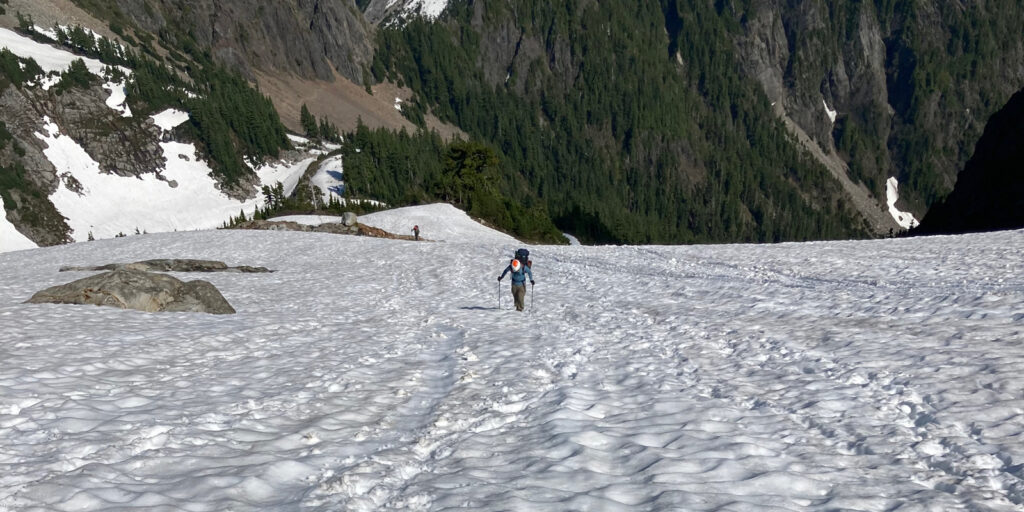
Release of Liability Agreement
You must read and agree to this Release of Liability:
I understand that during my participation in this Outing, I may be exposed to risks and hazards, foreseen or unforeseen, which are inherent and cannot be eliminated without diminishing the Outing.
These inherent risks include, but are not limited to, the dangers of serious personal injury, property damage, and death (“Injuries and Damages”) from exposure to the hazards of travel, location, and weather.
I agree that the Organizer has not tried to contradict or minimize my understanding of these risks. I know that Injuries and Damages can occur by natural causes or activities of other persons, animals, trip members, trip leaders or third parties, either as a result of negligence or because of other reasons. I understand that risks of such Injuries are involved in adventure travel such as this Outing and I accept that I must exercise extra care for my own person and for others around me in the face of such hazards.
I understand that on this Outing there may not be rescue or medical facilities or expertise necessary to deal with the Injuries to which I may be exposed.
To the fullest extent allowed by law, I agree to WAIVE, DISCHARGE CLAIMS, AND RELEASE FROM LIABILITY the Organizer from any and all liability on account of, or in any way resulting from Injuries and Damages, even if caused by the negligence of the Organizer or other participants in any way connected with this Outing. I further agree to HOLD HARMLESS the Organizer from any claims, losses, Injuries and Damages caused by my own negligence while a participant on the Outing.
I understand and intend that this assumption of risk and release is binding upon my heirs, executors, administrators and assigns. I have read the Outing description and this Release of Liability in its entirety and I freely and voluntarily assume all risks of such Injuries and notwithstanding such risks, I agree to participate in the Outing. I have read, I understand, and I agree to this Release of Liability.
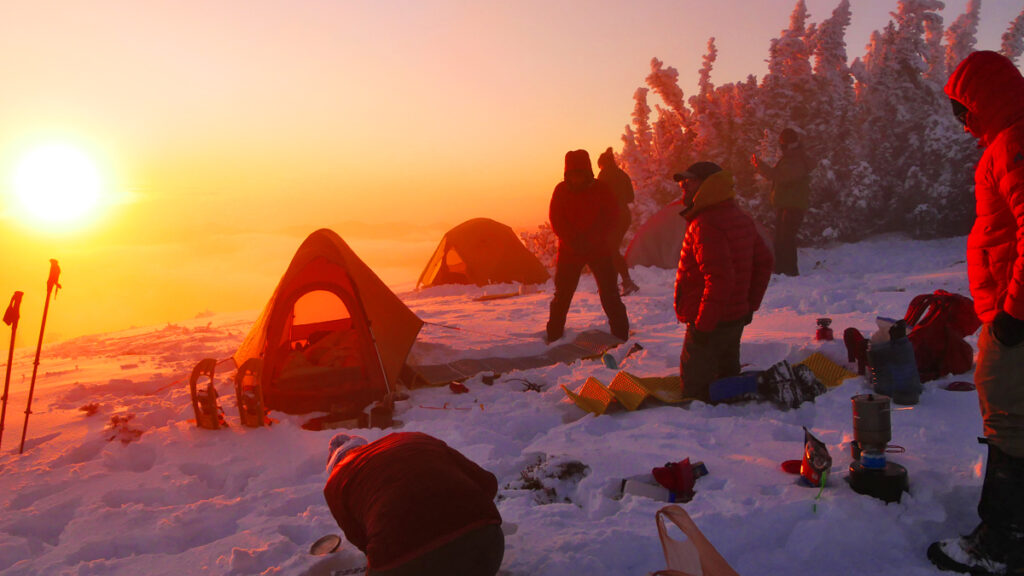
Necessary Gear and Redundancy
Some types of gear are required. Along with the usual ten essentials upgraded for cold weather, you must have
- Mountain terrain snowshoes
- Boots suitable for snowshoes and crampons. (Mountain climbing boots are not necessary).
- Snow baskets for your trekking poles are always recommended and required in deep unconsolidated snow.
- Warm layers
- 5+ R-value under your sleeping bag (BOTH a solid-core foam pad and an air mattress). The solid pad is essential and mainly for around camp but it can also go under your air mattress.
- Sleeping bag rated for the forecast or warmer. Usually, a 15-degree sleeping bag will work for the shoulder season and a zero-degree winter sleeping bag will work for most winter trips.
- Wind protection. If high wind is a potentiality in the forecast, bring goggles, a balaclava, hard-shell clothing, and down mittens (mittens are warmer than gloves).
- UV protection. During the months of February–July, trips on large snowfields require protection from snow blindness and severe sunburns.
For how to modify the standard ten essentials for winter, see The Fifteen Essentials for Winter Backpacking.
General winter backpacking tips, and information about sleeping bags, tents, and other winter gear can be found on the blog.
For a detailed look at layering, see Layering for Winter Backpacking.
Arrive self-sufficient
If you bring a heavy tent, expect to carry it yourself. If you become separated from the group, you need to have all the essentials necessary to be safe. If everyone is self-sufficient, there will be gear redundancy which adds safety. If, for example, someone’s air mattress fails, someone else can give up a solid-core mattress. If a stove fails, someone else can share.
If you get separated from the group or cannot make the destination or choose not to, you should have to capability to camp solo along the route, staying in the same spot until the group finds you or rejoins you the following day on their way out.
Adjust your gear based on circumstances, such as temperature, UV, and wind forecast, and terrain. Late winter is different from the early winter. When the days are longer and sunnier you must be prepared for intense blistering UV radiation reflecting up from the snow.
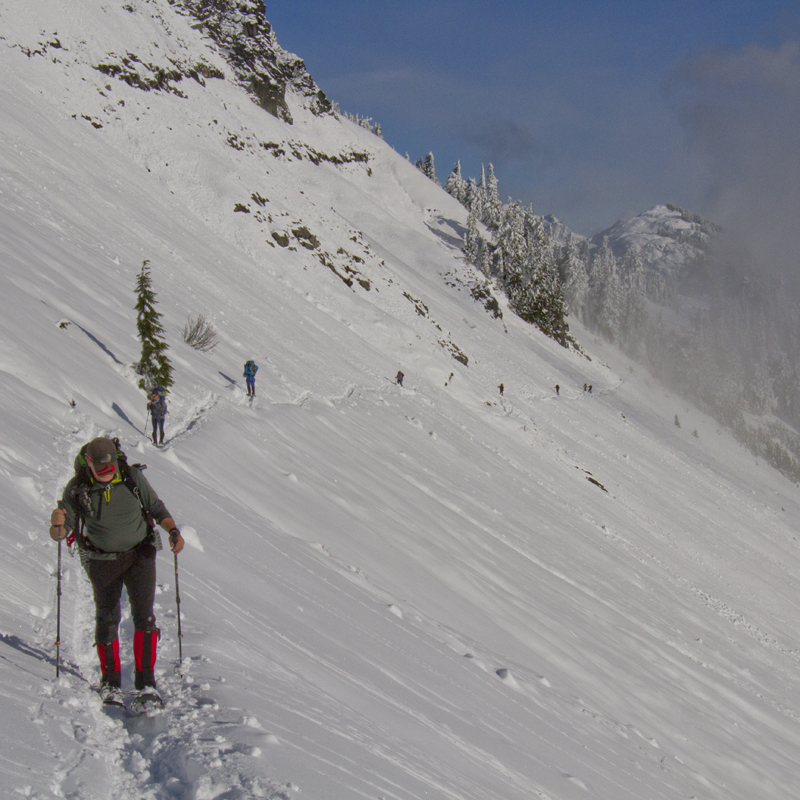
Pack Weight
You can bring a heavy pack and many people do. However, if your pack exceeds 35 lbs without food or snowshoes, it should be possible to reduce the weight. Learn how to remove excess gear and replace necessary gear with lighter versions. Consider discarding items that are not on the suggested basic winter gear list. For tips on reducing weight, see A Winter Backpack Under 30 lbs.
Do not compromise warmth or safety by going too light, but avoid overpacking. Heavy packs increase the chances of back injuries, accidental falls, exhaustion, and hypothermia. Even with snowshoes attached and food and water, a weekend winter pack should be no heavier than 35 lbs. A weekend pack with necessary gear, including snowshoes, food, water, and avalanche gear, can be 30–35lbs. If you have experience with heavier packs (regularly climb or are training for Mount Denali), then fine.
Difficulty, Experience, and Conditioning
Many people sign up with no prior snow camping experience and enjoy the activity. It helps if you read the tip sheet (or this article: Before You Go…) and ask questions from other group members who are experienced.
You do not have to be a young super athlete, but you do need to be in good mental and physical shape with sufficient conditioning to keep up. Snowshoeing with a heavy winter pack can be difficult and exhausting. Some trips require snowshoeing uphill all the available hours of daylight. Some winter trips are as short as 6 miles in two days, but shoulder-season trips can be up to 30+ miles and 8,000ft of elevation gain in two days. Know what kind of trip you are signing up for and don’t sign up for a trip that is beyond your abilities.
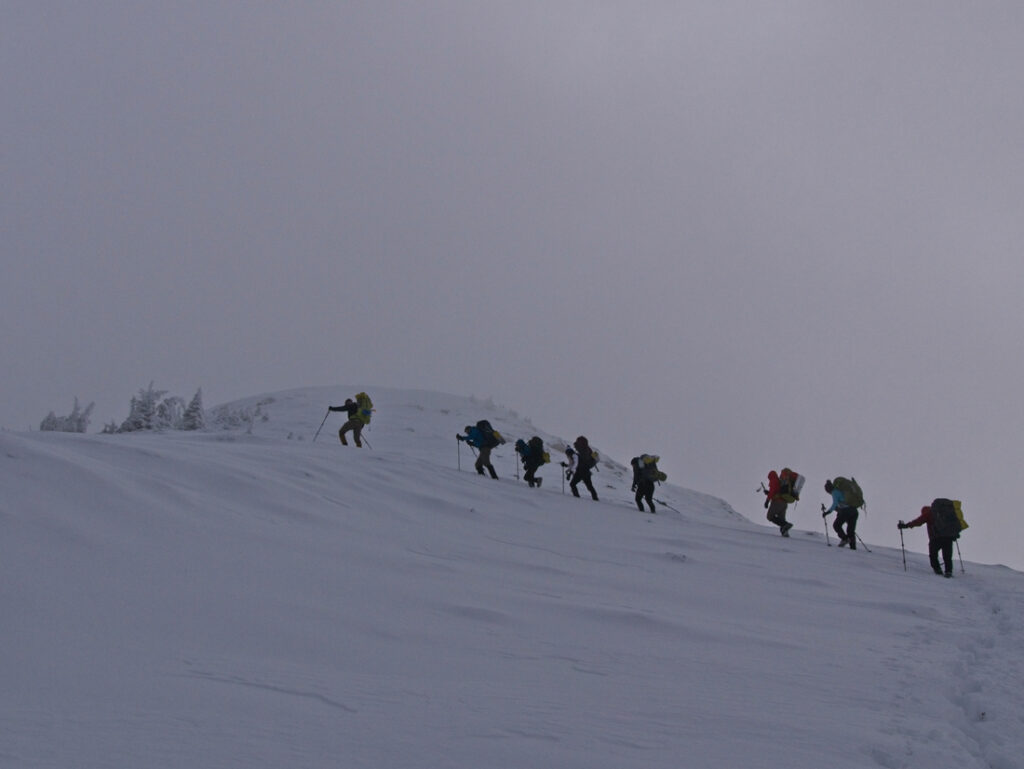
You should be experienced enough to know your abilities. If you have never snowshoed before, do some short-day snowshoe trips first. Ranger-led day trips are also available for beginners (https://www.nps.gov/mora/planyourvisit/rangerprograms.htm, http://www.discovernw.org/store_winter-snowshoe-program-at-snoqualmie-pass_SNOWSHOE01.html). You can also test some of your gear capabilities by winter car camping.
One of the main skills you need is the ability to layer clothes while hiking and in camp so as to not overheat or lose heat.
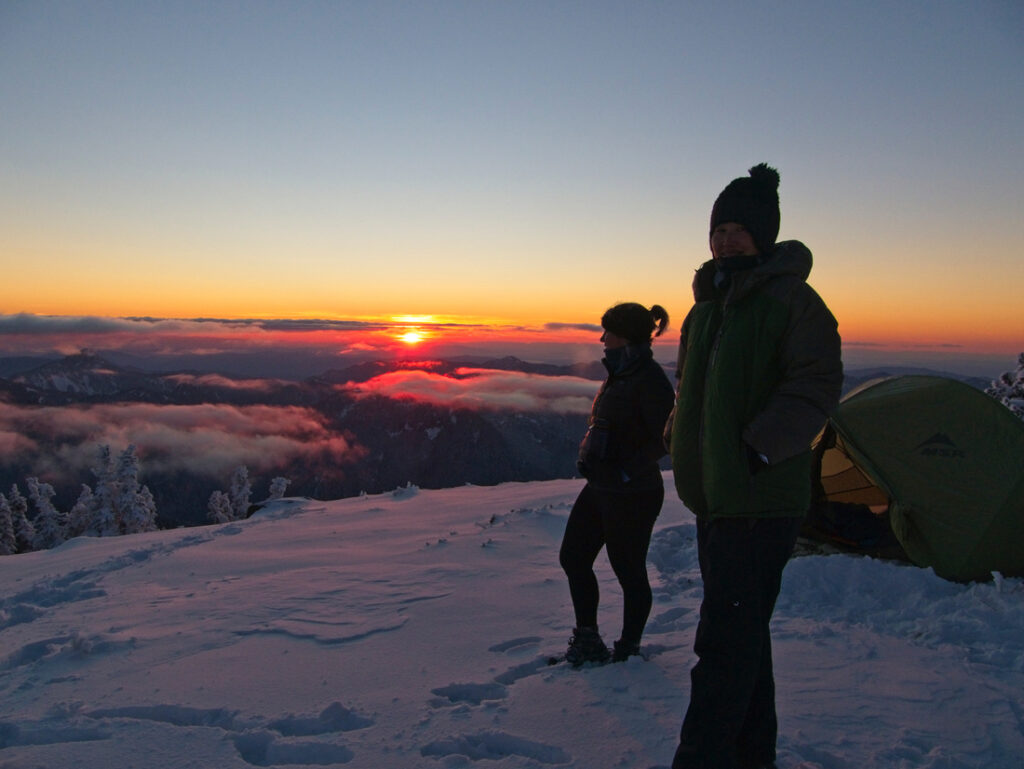
Additional Tips
To learn more about how to stay warm and comfortable at all times, please read the tips found on “Know Before You Go”. There is also a basic tip sheet with a gear list here: https://winterbackpacking.com/winter-backpacking-tip-list-1.pdf
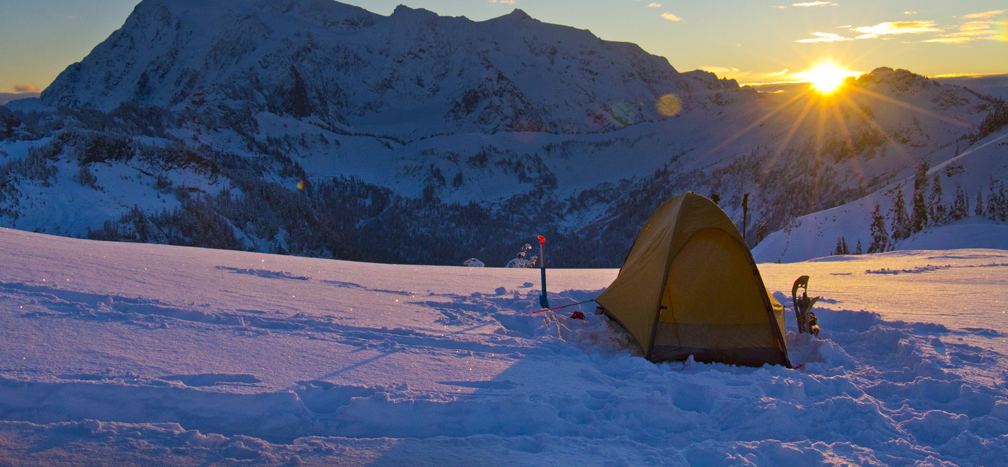
The Event WaitList
Everyone is welcome. Diversity is valued and we want to give new members opportunities. Some events have a waitlist and limited group size. If the waitlist is active, please sign in. To increase your chances of going, see “Special Considerations for the Waitlist” below.
Special Considerations for the Waitlist
Selection from the waitlist will be based on who signs up first. For some events, prior known experience or specialized gear may be required. When the group limit is small (3–6) exceptions to the group limit are sometimes made for persons who can enhance the safety of the group such as:
- ability to provide transportation, preferably AWD/4WD (most trips will only require two or three vehicles)
- known previous experience with winter backpacking (preference will be made to always include at least one other person with known winter experience)
- ability to keep up with the group (especially important for long trips) and willingness to stay together
- gear readiness (it helps if you communicate that your kit is equipped for the anticipated conditions)
- first-aid skills
- willingness to bring avalanche gear (transceiver, shovel, probe)
If any of the above describes you, send me a private message, because it could make a difference.
New and regular hikers are given priority over hikers who sign up but frequently drop out at the last minute. On many events those who are on the going list and waitlist will be asked to reconfirm. Those who don’t reconfirm will be moved to the not-going list in order to give the opportunity to others, so be sure to turn on your messages in the Meetup App.
You must be over 18 to participate.
Suggestions and comments are welcome. Reach out to us on the Meetup comment section, the blog posts, or our Facebook page.
